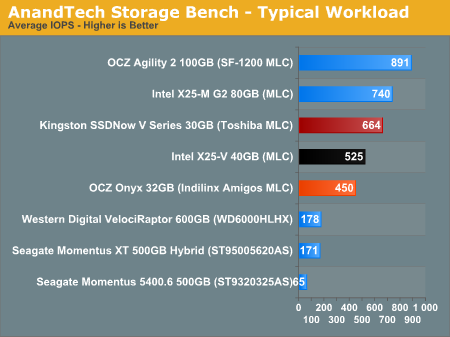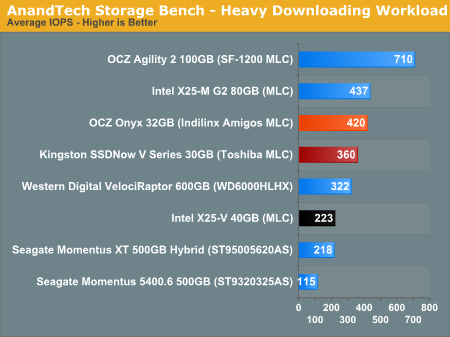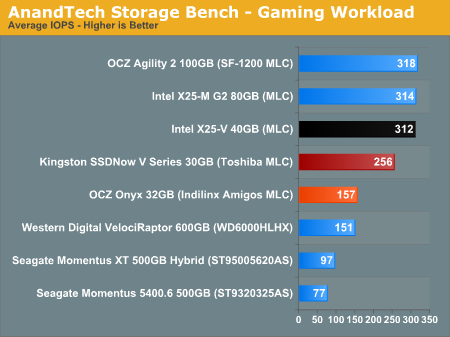2010 Value SSD (~$100) Roundup: Kingston and OCZ take on Intel
by Anand Lal Shimpi on June 3, 2010 12:01 AM ESTAnandTech Storage Bench
The first in our benchmark suite is a light usage case. The Windows 7 system is loaded with Firefox, Office 2007 and Adobe Reader among other applications. With Firefox we browse web pages like Facebook, AnandTech, Digg and other sites. Outlook is also running and we use it to check emails, create and send a message with a PDF attachment. Adobe Reader is used to view some PDFs. Excel 2007 is used to create a spreadsheet, graphs and save the document. The same goes for Word 2007. We open and step through a presentation in PowerPoint 2007 received as an email attachment before saving it to the desktop. Finally we watch a bit of a Firefly episode in Windows Media Player 11.
There’s some level of multitasking going on here but it’s not unreasonable by any means. Generally the application tasks proceed linearly, with the exception of things like web browsing which may happen in between one of the other tasks.
The recording is played back on all of our drives here today. Remember that we’re isolating disk performance, all we’re doing is playing back every single disk access that happened in that ~5 minute period of usage. The light workload is composed of 37,501 reads and 20,268 writes. Over 30% of the IOs are 4KB, 11% are 16KB, 22% are 32KB and approximately 13% are 64KB in size. Less than 30% of the operations are absolutely sequential in nature. Average queue depth is 6.09 IOs.
The performance results are reported in average I/O Operations per Second (IOPS):

Our storage suite puts more emphasis on sequential transfers than PCMark Vantage and thus Kingston gets the performance advantage here in our typical/light workload case. It's a very realistic workload and one that gives Kingston the overall advantage.
If there’s a light usage case there’s bound to be a heavy one. In this test we have Microsoft Security Essentials running in the background with real time virus scanning enabled. We also perform a quick scan in the middle of the test. Firefox, Outlook, Excel, Word and Powerpoint are all used the same as they were in the light test. We add Photoshop CS4 to the mix, opening a bunch of 12MP images, editing them, then saving them as highly compressed JPGs for web publishing. Windows 7’s picture viewer is used to view a bunch of pictures on the hard drive. We use 7-zip to create and extract .7z archives. Downloading is also prominently featured in our heavy test; we download large files from the Internet during portions of the benchmark, as well as use uTorrent to grab a couple of torrents. Some of the applications in use are installed during the benchmark, Windows updates are also installed. Towards the end of the test we launch World of Warcraft, play for a few minutes, then delete the folder. This test also takes into account all of the disk accesses that happen while the OS is booting.
The benchmark is 22 minutes long and it consists of 128,895 read operations and 72,411 write operations. Roughly 44% of all IOs were sequential. Approximately 30% of all accesses were 4KB in size, 12% were 16KB in size, 14% were 32KB and 20% were 64KB. Average queue depth was 3.59.

Our heavy workload is much more of a sequential write test and that's where Intel really falls short. Here OCZ's Onyx takes the cake as it offers the best sequential write speed out of the value drives.
The gaming workload is made up of 75,206 read operations and only 4,592 write operations. Only 20% of the accesses are 4KB in size, nearly 40% are 64KB and 20% are 32KB. A whopping 69% of the IOs are sequential, meaning this is predominantly a sequential read benchmark. The average queue depth is 7.76 IOs.

If you're mostly reading large amounts of data from your drive the X25-V and Kingston SSDNow V Series are your best bet. You won't be able to do much in the way of gaming on these tiny drives but any similar workloads should see results like these.










49 Comments
View All Comments
R-Smith - Tuesday, July 6, 2010 - link
+1Then again, the best idea might be to avoid an SSD because then PC's without SSD's won't seem so slow.
MobiusStrip - Monday, June 7, 2010 - link
"They simply are way to small" TOO. TOO small. T, O, Oracerx_is_alive - Thursday, June 3, 2010 - link
Seems like the 30GB OCZ Vertex is another good option in this price range. If its performance is anywhere close to the 120GB version in your SSD Bench, I wonder if it isn't a better option than the Onyx and the Kingston?Taft12 - Friday, June 4, 2010 - link
Performance of the 30GB Vertex is not close to the 120GB version.Mugur - Thursday, June 3, 2010 - link
Does the non-Intel drives have a tool equivalent with the Intel SSD Toolbox? I mean, if I'm not sure if TRIM works, I just run that utility (it takes about 3 seconds :-) )...Chloiber - Thursday, June 3, 2010 - link
The drives with Indilinxcontrollers (the normale one and ECO, I don't know about "Amigos" though!) have a "TRIM"-tool. You can manually trim under windows. It is beta though and should be used with care. For me, it always worked.Under Linux, you can issue a manual TRIM command anytime you want (google for hdparm and/or wiper.sh linux ). Also here, there are still problems, but again it worked for my Ultradrive perfectly well.
teohhanhui - Thursday, June 3, 2010 - link
And yes, I'll wait until the new Intel drives come out at the end of this year (presumably).Phate- - Thursday, June 3, 2010 - link
What about ssd's with the JMicron JMF612/JMF618 controllers? These are the real budget-ssd's, the Kingston SNV425-S2 64GB is by far the cheapest ssd (with only the 128GB version offering more GB/euro). And what about the Corsair Reactor Series R60, Corsair Performance series P64 and Corsair Extreme series E64. These drives have cost about the same as the Intel Postville 80GB when you look at GB/euro.I am not interested in the 30-40GB ssd's, they are to small. Neither am I interested in the high-end ssd's. I'm interested in an ssd with more then 40GB (and less then 80GB) with a decent capacity/performance/euro ratio.
Well to be precise, I AM interested in the smaller and faster ssd's, because ssd's interest me, and it are mostly wonderful articles, but these reviews hardly help me in my search for the perfect ssd for me. Namely the midrange.
loimlo - Thursday, June 3, 2010 - link
Kingston uses the same controller across their SSD series. In other words, SSDNOW V series 30/64/128GB drives share identical controller. You can base 64/128GB performance on Anand's 30GB review. That said, 64/128GB should be faster given higher read/write speed compared to 30GB version.Phate- - Thursday, June 3, 2010 - link
If so, then explain the difference between de V+ second series and the newer V second series. If they are exactly the same, why would they bother with releasing 2 exactly the same, but different named series?http://www.legitreviews.com/article/1197/1/
http://www.legitreviews.com/article/1237/7/
Too bad they didn't compare the ssd's with eachother though.